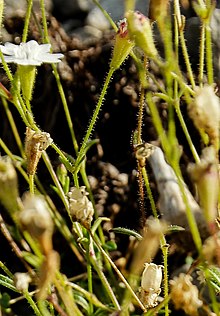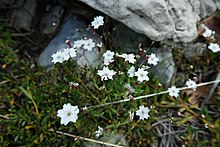Little ray seed
| Little ray seed | ||||||||||||
|---|---|---|---|---|---|---|---|---|---|---|---|---|

Small radiant seed ( Heliosperma pusillum ) |
||||||||||||
| Systematics | ||||||||||||
|
||||||||||||
| Scientific name | ||||||||||||
| Heliosperma pusillum | ||||||||||||
| Waldst. & Kit. |
The small radiant seed ( Heliosperma pusillum ) is a plant species within the carnation family (Caryophyllaceae). It belongs to the genus Heliosperma and, since it was previously counted among the ciliate herbs , it is also called lesser cattleweed . The small radiant seed is very similar to the rock catchfly ( Atocion rupestre ), which however prefers silicate soils .
description
Vegetative characteristics
The small radiant seed is a tender, perennial herbaceous plant , usually with short, more rarely with elongated and perennial shoot axes that are shifted into the ground. The primary root is thin, richly branched, and there are seldom delicate sprouted roots. It forms a lawn-like to loose cushion with a maximum diameter of 12 centimeters and 10 to 20 flower stems. Flowering stems are 10 to 20 (5 to 35) centimeters, ascending, very thin, more or less glabrous and sticky on top.
The leaves are loosely distributed, the lower ones small, spatulate-lanceolate, petiolate, the others larger, linear to linear-lanceolate, ciliate at the base.
Generative characteristics
The inflorescence is a dichasium or coil in which usually two to three (one to six) flowers are loosely distributed; regularly with several coflorescences. The hermaphrodite flowers are fivefold. The calyx 3–7 mm, top-shaped, glabrous or slightly glandular, indistinct ten-nerved; Cup teeth about half as long as the tube. The white, rarely pink or purple petals are 7–9 mm long; Nail bald; Plate obovate, four- or two-toothed. The secondary crown is about 1 mm long and in two parts. There are three or rarely five styluses.
The capsule fruit is 5–8 mm long, little or no protruding from the calyx, broadly ovoid to almost spherical, without basal septa. The carpophor is short. The seeds are 1.2–1.6 mm long, grainy, rough, on the back with densely packed, long (1 / 3-1 / 2 of the diameter), radiating papillae. The flowering period extends from June to September.
The number of chromosomes is 2n = 24.
distribution
The small radiated seed is widespread from the Pyrenees over the Alps to the Southern Carpathians . However, it no longer occurs in the Eastern Carpathians. The distribution area extends from north to south from the Tatra Mountains to the Pindus. The populations from the Neretva to northern Greece mostly belong to the subspecies Heliosperma pusillum subsp. monachorum , which was detected in 2011 for Albania and 1997 for North Greece. A precise territorial demarcation to the subspecies Heliosperma pusillum subsp. albanicum is currently not possible in 1997. The height limit increases noticeably from north to south; In Albania, the populations in the Nemercka were observed at altitudes of 2200 to 2450 meters, so the occurrences themselves are in the immediate summit area.
Occurrence
The small radiant seed thrives in humid locations on wet rocks (always shaded at lower altitudes), in rock niches, on rock debris, in boggy rivulets, in brook rubble or as alpine drift in river gravel, mainly on lime and base-rich substrate, often rooting in moss blankets or moss cushions. In Central Europe it is scattered in subalpine and alpine spring meadows, spring niches, on boggy rivulets and overflowing rocks on seeping, calcareous, mild, humus-rich, clayey-loamy stone soils. It is a character species of the Cratoneuretum falcati, but also rarely occurs as a floating debris in the gravel of the Alpine rivers. In addition, rooted in damp fine debris groups or in moss blankets or moss cushions. Characteristic above all for limestone spring corridors (Cratoneurion commutati, e.g. Cratoneuro-Arabidetum), also in freshly moist variants of limestone crevice societies (Potentillion caulescentis), calcareous grass (Caricetum ferrugineae) or on humus in the leg pines. In the Alps it occurs at altitudes from 1350 to 2300 meters.
In the north-western Dinarides of Slovenia and Croatia, the small radiated seed is a species of character in snow valley societies with the Drepanoclado-Heliospermetum association. Among other things, besides the deciduous moss Sanionia uncinata, it is also associated with the stump-leaved willow such as the Ice Age relic of the white silver arum. During vegetation-ecological studies in snow valleys in Snežnik and Velebit , a preference of the small ray seeds in the mountain locations for cool and humid locations with particularly long-lasting snow cover, late aperitif, low solar radiation and low temperatures was observed. Such microclimatic locations in the Liburnian Karst are among other frost sinkholes of the high altitudes, which are preferred locations of the Drepanoclado uncinati-Heliospermetum pusilli Surina et Vreš 2004 association due to temperature inversion with the accumulation of frost days . The locations in Slovenia are at altitudes from 1100 to 1300 meters and in northwestern Croatia from 1400 to 1500 meters. There are azonal locations in subalpine beech and spruce forests within closed frost karst dolines, which are attributed to the subalpine vegetation zone due to the temperature conditions.
Snow valleys of the Herzegovinian Čvrsnica show next to Heliosperma pusillum , Saxifraga prenja , Papaver kerneri , Ranunculus montanus , Saxifraga sedoides subsp. prenja and Hutchinsia alpina subsp. brevicaulis .
In the Allgäu Alps, the Kleine Strahlensame rises on the north ridge of the Biberkopf in Bavaria to an altitude of up to 2350 meters.
Diseases and pests
The small radiation seed is attacked by the anther blight Microbotryum heliospermae, which was first described in 2012 . This converts the stamens into dark spore beds ( Sori ).
Systematics
It was first published under the name ( Basionym ) Silene pusilla Waldst. & Kit. Other synonyms for Heliosperma pusillum (Waldst. & Kit.) Vis. are for example: Heliosperma quadridentata auct., Ixoca pusilla (Waldst. & Kit.) Soják , Silene quadrifida auct.
One can distinguish the following subspecies:
- Heliosperma pusillum (Waldst. & Kit.) Vis. subsp. pusillum
- Heliosperma pusillum subsp. monachorum (Vis. & Pančić) Niketić & Stevan. : It is widespread in the south-east Dinarides between Prenj and the Prokletije Mountains.
- Heliosperma pusillum subsp. albanicum (K.Malý) Niketic & Stevan.
Heliosperma pusillum subsp. monachorum
The subspecies Heliosperma pusillum subsp. monachorum is characterized by stronger growth with broader basal leaves, the glandular hairs and the shorter papillae of the seeds. It is often considered by authors in its area of distribution in Serbia, Bosnia and Herzegovina and Montenegro as a separate species - Heliosperma monachorum Vis. et Pančić . In these descriptions, this cushion-forming plant reaches heights of growth of 10–40 centimeters. It has numerous rigid stems with greatly elongated internodes . The opposite leaves are up to 4 centimeters long and 3 millimeters wide, belt-shaped to elliptically elongated. The stem and calyx are densely covered with unicellular glandular hairs. The inflorescence is a loose dichasium or the flowers are rarely single. The crown is white with a wreath, the lamina is 1/3 incised with two to six, rarely eight teeth. The seed papillae are shorter than 1/3 the diameter of the seeds. The flowering period extends from July to September. It is a character species of the Moehringion muscosae in Serbia and Bosnia . From the Durmitor it was described by Josif Pančić in 1875 from moss cushions in association with the black crowberry and the blunt-leaved willow , a kind of snow valley character.
Pančić gave the epithet monachorum to Rača near Derventa in what is now the Tara National Park, after it was first found "far from the monastery" .
Protection status
The subspecies Heliosperma pusillum subsp. monachorum enjoys the highest protection status in Serbia. Their export and collection is strictly prohibited there.
literature
- Xaver Finkenzeller: Alpine flowers. Munich 2003, ISBN 3-576-11482-3 .
- Manfred A. Fischer , Wolfgang Adler, Karl Oswald: Excursion flora for Austria, Liechtenstein and South Tyrol. 2nd, improved and enlarged edition. State of Upper Austria, Biology Center of the Upper Austrian State Museums, Linz 2005, ISBN 3-85474-140-5 .
Individual evidence
- ↑ Vladimir Stevanović, Vladimir Vladimirov, Marjan Niketić et al .: Plant species and subspecies discoverd by Dr. Josif Pančić 1 - Distribution and floristic importance. In: Botanica Serbica. Volume 38, Issue 2, 2014, pp. 251-268. online (PDF).
- ↑ a b c d e f Karl Heinz Rechinger (Hrsg.): Illustrated flora of Central Europe. Pteridophyta, Spermatophyta . Founded by Gustav Hegi. 2nd, completely revised edition. Volume III. Part 2: Angiospermae: Dicotyledones 1 (Phytolaccaceae - Portulacaceae) . Paul Parey, Berlin / Hamburg 1979, ISBN 3-489-60020-7 (published in deliveries 1959–1979). Here pp. 1110–1111
- ↑ a b c Erich Oberdorfer : Plant-sociological excursion flora for Germany and neighboring areas. 8th edition, Stuttgart, Verlag Eugen Ulmer, 2001, ISBN 3-8001-3131-5 , p. 364.
- ↑ Lulezim Shuka, Sadik Malo, Kit Tan: New chorological data and floristic notes for Albania. In: Botanica Serrbica. Volume 35, Issue 2, 2011, pp. 157-162. Here p. 158.
- ^ W. Greuter 1997: Silene. In: Arne Strid, Kit Tan (ed.): Flora Hellenica. Volume 1, Koeltz Scientific Books, Königstein, pp. 291-295.
- ↑ Ž. Modrić Surina, B. Surina: Snowbed Vegetation in Croatia: Phytosociology, ecology and conservation status. In: Plant Biosystems. Volume 144, Issue 4, 2010, pp. 747-768.
- ↑ Boštjan Surina, Branko Vreš: The Association Drepanoclado uncinati-Heliospermetum pusilli (Arabidetalia caeruleae, Thlaspietea rotundifolii) in the Trnovski gozd Plateau (Slovenia, NW Dinaric Mts). In: Hacquetia. 8/1, 2009, 31-40.
- ↑ Ž. Modrić Surina, B. Surina 2010: p. 758.
- ↑ Ž. Modrić Surina, B. Surina 2010: p. 761.
- ^ Ivo Horvat, Vjekoslav Glavač, Heinz Ellenberg: Vegetation Southeast Europe. Gustav Fischer, Stuttgart 1974. Here p. 627.
- ↑ Erhard Dörr, Wolfgang Lippert : Flora of the Allgäu and its surroundings. Volume 1, IHW-Verlag, Eching near Munich, 2001, ISBN 3-930167-50-6 , p. 478.
- ↑ Marcin Piątek, Matthias Lutz, Anna Ronikier et al .: Microbotryum heliospermae, a new anther smut fungus parasitic on Heliosperma pusillum in the mountains of the European Alpine System. In: Fungal Biology. 116, 2012, 185-195. online .
- ↑ Karl Heinz Rechinger (Ed.): Illustrated flora of Central Europe. Pteridophyta, Spermatophyta . Founded by Gustav Hegi. 2nd, completely revised edition. Volume III. Part 2: Angiospermae: Dicotyledones 1 (Phytolaccaceae - Portulacaceae) . Paul Parey, Berlin / Hamburg 1979, ISBN 3-489-60020-7 (published in deliveries 1959–1979). Here p. 1112
- ↑ Heliosperma monachorum Vis. et Pančić, Pančić Herbarium of the Biological Faculty of Belgrade Heliosperma monachorum Vis. et Pančić 1965
- ↑ Josif Pančić 1875: Elechnus Plantarum Vascularium Quas Astate a. 1873 in Crna Gora. P. 12, Belgrade.
- ↑ Moreno Clementi, Goran Anačkov, Antonella Miola, Snežana Vukojičić: Typification and taxonomical notes on the names published by Roberto de Visiani and Josif Pančić in Plantae Serbicae Rariores aut Novae — Decas II. In: Phytotaxa. Volume 229 (1), 2015, pp. 29–44. (PDF)
- ↑ inches of Serbia, Official Gazette of Glasnik - "Sl glasnik RS." - br. 47/2011 (PDF)
Web links
- Heliosperma pusillum (Waldst. & Kit.) Rchb., Kleiner Strahlensame. In: FloraWeb.de.
- Heliosperma pusillum subsp. pusillum (Waldst. & Kit.) Rchb., Kleiner Strahlensame. In: FloraWeb.de.
- Profile and distribution map for Bavaria . In: Botanical Information Hub of Bavaria .
- Silene pusilla Waldst. & Kit. In: Info Flora , the national data and information center for Swiss flora . Retrieved October 8, 2015.
- Thomas Meyer: Data sheet with identification key and photos at Flora-de: Flora von Deutschland (old name of the website: Flowers in Swabia )






